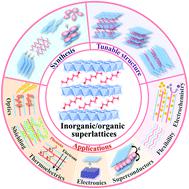当前位置:
X-MOL 学术
›
Chem. Soc. Rev.
›
论文详情
Our official English website, www.x-mol.net, welcomes your feedback! (Note: you will need to create a separate account there.)
Hybrid superlattices of two-dimensional materials and organics
Chemical Society Reviews ( IF 46.2 ) Pub Date : 2020-09-02 , DOI: 10.1039/d0cs00148a Yujia Huang 1, 2, 3, 4, 5 , Jia Liang 1, 2, 3, 4, 5 , Chen Wang 1, 2, 3, 4, 5 , Shujia Yin 1, 2, 3, 4, 5 , Wangyang Fu 1, 2, 3, 4, 5 , Hongwei Zhu 1, 2, 3, 4, 5 , Chunlei Wan 1, 2, 3, 4, 5
Chemical Society Reviews ( IF 46.2 ) Pub Date : 2020-09-02 , DOI: 10.1039/d0cs00148a Yujia Huang 1, 2, 3, 4, 5 , Jia Liang 1, 2, 3, 4, 5 , Chen Wang 1, 2, 3, 4, 5 , Shujia Yin 1, 2, 3, 4, 5 , Wangyang Fu 1, 2, 3, 4, 5 , Hongwei Zhu 1, 2, 3, 4, 5 , Chunlei Wan 1, 2, 3, 4, 5
Affiliation

|
Two-dimensional (2D) materials have received extensive interest due to their exceptional properties. It is strongly required to assemble 2D materials in bulk quantities for macroscopic applications, but this is highly restricted by the aggregation of 2D materials. Constructing three-dimensional (3D) hybrid superlattices of alternating 2D materials and organic molecule layers provides a new path to access the exceptional properties of 2D materials in bulk quantities. In this tutorial review, the emerging concept of hybrid inorganic/organic superlattices is systematically illustrated. The abundant compositions and the various structures of inorganic and organic sublattices in hybrid superlattices are presented, followed by a summary of the chemical interactions between them. Many facile techniques have been developed for hybrid superlattices, enabling precise control of the structure. There are also various interesting mechanisms inside unique hybrid inorganic/organic superlattices that can help tune the properties, including electron transfer, quantum confinement, interlayer coupling, multiple interface effects, etc. The rich chemistry and abundant mechanisms of these hybrid superlattices can enhance the performance beyond the reach of existing materials, and provide new opportunities in various applications, including rechargeable batteries, catalysis, thermoelectrics, advanced electronics, superconductors, optoelectronics, etc.
中文翻译:

二维材料和有机物的混合超晶格
二维(2D)材料因其卓越的性能而受到广泛关注。对于宏观应用,强烈要求大量组装2D材料,但这受到2D材料聚合的高度限制。构造由交替的2D材料和有机分子层构成的三维(3D)混合超晶格提供了一条新的途径来批量访问2D材料的优异性能。在本教程的复习中,系统地说明了混合无机/有机超晶格的新兴概念。介绍了混合超晶格中无机和有机亚晶格的丰富组成和各种结构,然后概述了它们之间的化学相互作用。已经为混合超晶格开发了许多简便的技术,实现结构的精确控制。独特的无机/有机混合超晶格内部还存在各种有趣的机制,可以帮助调整特性,包括电子转移,量子限制,层间耦合,多界面效应,等丰富的化学和这些混合超晶格的丰富的机制可以增强超越现有材料的范围的业绩,并在各种应用,包括可充电电池,催化,热电,先进的电子设备,超导,光电,提供新的机会等。
更新日期:2020-10-05
中文翻译:

二维材料和有机物的混合超晶格
二维(2D)材料因其卓越的性能而受到广泛关注。对于宏观应用,强烈要求大量组装2D材料,但这受到2D材料聚合的高度限制。构造由交替的2D材料和有机分子层构成的三维(3D)混合超晶格提供了一条新的途径来批量访问2D材料的优异性能。在本教程的复习中,系统地说明了混合无机/有机超晶格的新兴概念。介绍了混合超晶格中无机和有机亚晶格的丰富组成和各种结构,然后概述了它们之间的化学相互作用。已经为混合超晶格开发了许多简便的技术,实现结构的精确控制。独特的无机/有机混合超晶格内部还存在各种有趣的机制,可以帮助调整特性,包括电子转移,量子限制,层间耦合,多界面效应,等丰富的化学和这些混合超晶格的丰富的机制可以增强超越现有材料的范围的业绩,并在各种应用,包括可充电电池,催化,热电,先进的电子设备,超导,光电,提供新的机会等。



























 京公网安备 11010802027423号
京公网安备 11010802027423号